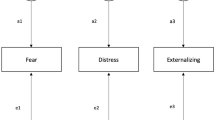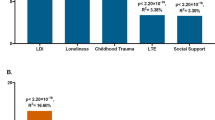Abstract
Purpose
Resilience to stressful life events (SLEs), which increase risk of psychopathology, is influenced by genetic factors. The purpose of this paper was to map the overlap of etiologic risk factors for resilience onto the broad psychopathological map. Resilience was defined as the difference between the twins’ total score on a broad measure of internalizing symptoms and their predicted score based on their cumulative exposure to SLEs.
Methods
Cholesky decompositions were performed with OpenMx to quantify the overlap in genetic and environmental risk factors between resilience and four phenotypes [major depression (MD), generalized anxiety disorder (GAD), alcohol abuse or dependence (AAD), and antisocial personality disorder (ASPD)].
Results
The genetic factors that influence resilience account for 42 and 61 % of the heritability of MD and GAD, respectively, and 20 and 18 % for AAD and ASPD, respectively. The latent genetic contribution to MD was shared 47 % with resilience, and for AAD, this estimate was lower (23 %). The shared environmental covariance was nominal.
Conclusions
Genetic influences on resilience contribute to internalizing phenotypes to a higher degree than to externalizing phenotypes. Environmental influences can also have an enduring effect on resilience. However, virtually all of the covariance between resilience and the phenotypes was genetic.




Similar content being viewed by others
Notes
These numbers do not sum because all possible pairings for triplet and quadruplet sets were included.
Model III with a qualitative sex effect for resilience fits slightly better than model V that did not have any sex effects (AICs = 3308.75 vs. 3309.84, respectively), but for parsimony, we chose to fit the nested models from the model without any sex effects.
Model XI with a qualitative sex effect for ASPD fits slightly better than model XIII that did not have any sex effects (AICs = 11,860.41 vs. 11,861.13, respectively), but for parsimony, we chose to fit the nested models from the model without any sex effects.
References
Battle CL et al (2004) Childhood maltreatment associated with adult personality disorders: findings from the Collaborative Longitudinal Personality Disorders Study. J Pers Disord 18(2):193–211
Pietrzak RH et al (2011) Prevalence and Axis I comorbidity of full and partial posttraumatic stress disorder in the United States: results from Wave 2 of the National Epidemiologic Survey on Alcohol and Related Conditions. J Anxiety Disord 25(3):456–465
Bonanno GA (2004) Loss, trauma, and human resilience. Have we underestimated the human capacity to thrive after extremely aversive events? Am Psychol 59:20–28
Rutter M (2006) Implications of resilience concepts for scientific understanding. Ann NY Acad Sci 1094:1–12
Amstadter AB, Myers JM, Kendler KS (2014) Psychiatric resilience: longitudinal twin study. Br J Psychiatry J ment sci 205(4):275–280. doi:10.1192/bjp.bp.113.130906
Kim-Cohen J et al (2004) Genetic and environmental processes in young children’s resilience and vulnerability to socioeconomic deprivation. Child Dev 75(3):651–668
Broadman JD, Blalock CL, Button TMM (2008) Sex differences in the heritability of resilience. Twin Res Hum Genet 11(1):12–27
Kendler KS, Myers J (2014) The boundaries of the internalizing and externalizing genetic spectra in men and women. Psychol Med 44(3):647–655. doi:10.1017/S0033291713000585
Kendler KS, Prescott CA (2006) Genes, environment, and psychopathology: understanding the causes of psychiatric and substance use disorders. The Guildford Press, New York
Kendler KS, Prescott CA (1999) A population-based twin study of lifetime major depression in men and women. Arch Gen Psychiatry 56:39–44
Derogatis LR, Lipman RS, Covi L (1973) SCL-90: an outpatient psychiatric rating scale–preliminary report. Psychopharmacol Bull 9(1):13–28
Kendler KS et al (1995) Stressful life events, genetic liability, and onset of an episode of major depression in women. Am J Psychiatry 152:833–842
Amstadter AB et al (2013) Potentially traumatic event exposure, posttraumatic stress disorder, and axis I and II comorbidity in a population based study of Norwegian young adults. Soc Psychiatry Psychiatr Epidemiol 48(2):215–223
Follette VM et al (1996) Cumulative trauma: the impact of child sexual abuse, adult sexual assault, and spouse abuse. J Trauma Stress 9:25–35
Suliman S et al (2009) Cumulative effect of multiple trauma on symptoms of posttraumatic stress disorder, anxiety, and depression in adolescents. Compr Psychiatry 50(2):121–127
American Psychiatric Association (1994) Diagnostic and statistical manual of mental disorders, 4th edn. Author, Washington
Spitzer RL et al (1995) Structured clinical interview for DSM-IV. American Psychiatric Press, Washington
Neale MC, Cardon LR (1992) Methodology for genetic studies of twins and families. Kluwer, Dordrecht
Akaike H (1987) Factor analysis and AIC. Psychometrika 52:317–332
Kendler KS et al (2003) Life event dimensions of loss, humiliation, entrapment, and danger in the prediction of onsets of major depression and generalized anxiety. Arch Gen Psychiatry 60(8):789–796
Kendler KS, Karkowski LM, Prescott CA (1998) Stressful life events and major depression: risk period, long-term contextual threat, and diagnostic specificity. J Nerv Ment Dis 186(11):661–669
Roemer L et al (1998) Preliminary investigation of the role of previous exposure to potentially traumatizing events in generalized anxiety disorder. Depress Anxiety 4(3):134–138
Amstadter AB et al (2009) Posttyphoon prevalence of posttraumatic stress disorder, major depressive disorder, panic disorder, and generalized anxiety disorder in a Vietnamese sample. J Trauma Stress 22(3):180–188
Kendler KS et al (2011) The relationship between genetic and environmental influences on common internalizing psychiatric disorders and mental well-being. Behav Genet 41:641–650
Hettema JM et al (2006) A population-based twin study of the relationship between neuroticism and internalizing disorders. Am J Psychiatry 163(5):857–864
Poythress NG et al (2010) Using the PCL-R to help estimate the validity of two self-report measures of psychopathology with offenders. Assessment 17(2):206–219
Mellman TA et al (1992) Phenomenology and course of psychiatric disorders associated with combat related posttraumatic stress disorder. Am J Psychiatry 149:1568–1574
Acknowledgments
This work was supported in part by NIH Grants K02 AA023239 R01 AA020179, P20 AA10782, R37 AA011408, R37 DA18673 and R01 DA22989. The Mid-Atlantic Twin Registry is supported by NIH Grant UL1RR031990.
Author information
Authors and Affiliations
Corresponding author
Ethics declarations
Conflict of interest
The authors report no competing interests.
Rights and permissions
About this article
Cite this article
Amstadter, A.B., Maes, H.H., Sheerin, C.M. et al. The relationship between genetic and environmental influences on resilience and on common internalizing and externalizing psychiatric disorders. Soc Psychiatry Psychiatr Epidemiol 51, 669–678 (2016). https://doi.org/10.1007/s00127-015-1163-6
Received:
Accepted:
Published:
Issue Date:
DOI: https://doi.org/10.1007/s00127-015-1163-6




